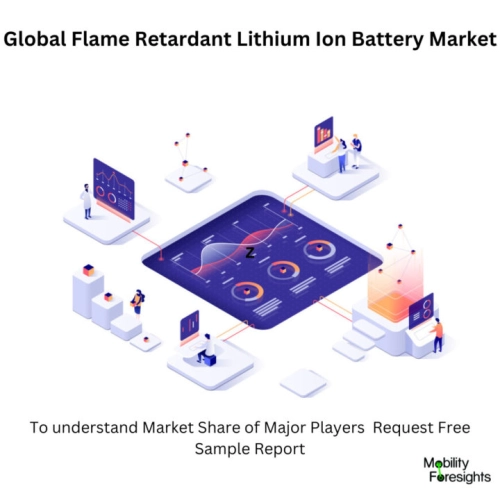FLAME RETARDANT LITHIUM ION BATTERY MARKET
KEY FINDINGS
- The demand for EVs is increasing globally due to rising fuel prices, growing awareness of environmental concerns, and government incentives. This is leading to increased demand for Lithium Ion Battery Flame Retardant.
- The price of lithium-ion battery flame retardant is expected to continue to increase in the coming years, driven by the growing demand for electric vehicles and grid energy storage systems. However, the price of flame retardants for consumer electronics is expected to remain relatively stable.
- There is a growing concern about EVs' safety, especially regarding fire hazards. This is because EV batteries are highly flammable. Lithium Ion Battery Flame Retardant can help to improve the safety of EVs by reducing the risk of fires.
- Nitrogen-based flame retardants are poised for significant growth due to their inherent advantages over traditional phosphorus-based flame retardants. They offer enhanced thermal stability, meaning they can withstand higher temperatures without decomposing and potentially causing fires. This is crucial for lithium-ion batteries, which are susceptible to overheating and thermal runaway.
- Inorganic flame retardants are expected to gain traction due to their exceptional thermal stability and compatibility with lithium-ion batteries. They are non-combustible and can withstand extremely high temperatures without decomposing, making them suitable for batteries operating under harsh conditions.
- Many governments are implementing stringent regulations on the safety of EVs, including requirements for the use of Lithium Ion Battery Flame Retardant. This is expected to drive the growth of the Lithium Ion-retardant material market.
- The increasing popularity of EVs is a major driver of demand for lithium-ion battery flame retardants. As EVs become more affordable and have longer ranges, they are becoming more attractive to consumers. This is leading to an increase in the production of EVs, which in turn is driving demand for lithium-ion battery flame retardants.
- Lithium-ion batteries are prone to overheating and catching fire, which is a major safety concern. This is why automakers are investing heavily in the development of new battery technologies that are less likely to catch fire. In the meantime, flame retardants are being used to mitigate the risk of fire.
- Some traditional flame retardants have been linked to environmental and health hazards, leading to a demand for more environmentally friendly alternatives. Battery manufacturers are developing new flame retardants that are less harmful to the environment and human health, reducing the environmental impact of EV batteries.
- EVs are demanding high-performance batteries that can deliver long-range and fast charging. Flame retardants are being used to improve the performance of lithium-ion batteries, making them more suitable for EV applications.
- Asia Pacific is expected to be the largest market for Lithium Ion battery Flame retardant during the forecast period. This is due to the increasing demand for EVs in countries such as China, India, and Japan.
- The European region is expected to be the second-largest market for Lithium Ion- battery flame retardant during the forecast period. This is due to the presence of a large number of EV manufacturers in the region and the stringent government regulations on EV safety.
- Lithium Ion Battery Flame retardant manufacturers are constantly developing new and innovative products to meet the changing needs of the EV industry. For example, some manufacturers are developing Lithium Ion Battery Flame Retardants that are made from sustainable materials or that are more effective at preventing fires.
- Governments around the world are providing support to the EV industry in the form of subsidies and tax breaks. This is expected to further boost the demand for Lithium Ion-retardant market in the coming years.
FLAME RETARDANT LITHIUM ION BATTERY MARKET OVERVIEW
The increasing global shift toward electric vehicles, driven by environmental concerns and government initiatives, is a primary factor boosting the demand for Lithium Ion Battery Flame Retardant in EVs.With safety regulations becoming more stringent globally, the automotive industry, including electric vehicles, is witnessing a growing emphasis on fire safety standards. This drives the need for Lithium Ion Battery Flame Retardant to enhance overall vehicle safety.
The market includes various Lithium Ion Battery Flame retardants, such as polymers, fabrics, coatings, and insulation materials, designed to meet the specific safety requirements of electric vehicles. The cost of Lithium Ion Battery Flame Retardant remains a challenge for manufacturers, impacting the overall cost structure of electric vehicles. Balancing safety standards with cost-effectiveness is a key consideration for industry players.
Lithium Ion Battery Flame Retardant plays a crucial role in the design of battery packs for electric vehicles. They are used in cell encapsulation and pack design to mitigate the risk of thermal runaway and fire propagation in the event of a malfunction. Ongoing research involves the exploration of nanomaterials and advanced coatings to enhance flame resistance without compromising other material properties. These innovations aim to address both safety and weight considerations in electric vehicles.
INTRODUCTION TO FLAME RETARDANT LITHIUM ION BATTERY MARKET
The powder coating of an electric vehicle (EV) battery is particularly prepared for applications requiring electrical insulation and possesses dielectric insulator qualities.
Chemicals known as flame retardants are added to materials to stop or delay the spread of fire. They are employed in a variety of commercial and consumer goods to lessen the ignitability of materials.
FLAME RETARDANT LITHIUM ION BATTERY MARKET SIZE AND FORECAST

The global Lithium Ion Battery Flame Retardant market accounted for $XX Billion in 2023 and is anticipated to reach $XX Billion by 2030, registering a CAGR of XX% from 2024 to 2030.
TRENDS IN THE LITHIUM ION BATTERY FLAME RETARDANT MARKET
Increasing demand for environmentally friendly flame retardants:
- Environmental concerns: Traditional flame retardants, such as polybrominated diphenyl ethers (PBDEs), have been linked to several environmental and health problems. PBDEs are persistent in the environment and can bioaccumulate in organisms, leading to adverse health effects.
- Consumer demand: Consumers are increasingly demanding products that are made with environmentally friendly materials. This is driving demand for biodegradable flame retardants and less toxic than traditional flame retardants.
Development of multifunctional flame retardants:
Multifunctional flame retardants are being developed to provide additional benefits beyond fire retardancy. These additional benefits can include thermal management. Multifunctional flame retardants can help to manage the heat generated by lithium-ion batteries, which can help to prevent overheating and thermal runaway.
Growing adoption of inorganic flame retardants:
Inorganic flame retardants are being increasingly adopted due to their several advantages over traditional flame retardants:
- Stability: Inorganic flame retardants are stable and are not prone to decomposition, which can make them more effective in preventing fires.
- Compatibility: Inorganic flame retardants are compatible with a wide variety of battery chemistries, which makes them more versatile than traditional flame retardants.
Stringent regulations and standardization efforts:
Regulatory bodies are implementing stricter safety standards for lithium-ion batteries due to the potential for fires and explosions. These safety standards are designed to reduce the risk of these incidents and to protect consumers and the environment. Harmonization of safety standards: Regulatory bodies are also working to harmonize safety standards across different regions. This will make it easier for battery manufacturers to comply with safety regulations and will help to ensure that lithium-ion batteries are safe regardless of where they are manufactured or sold.
FLAME RETARDANT LITHIUM-ION BATTERY MARKET NEW PRODUCT LAUNCH
Albemarle announced the launch of a new lithium-ion battery flame retardant.
ALPHAGUARD FR-200 is a high-performance inorganic flame retardant based on aluminum hydroxide. It was launched in 2023 and is known for its enhanced compatibility with cathode chemistries, which are the materials used in the positive electrodes of lithium-ion batteries. This enhanced compatibility makes ALPHAGUARD FR-200 a good choice for use in high-energy-density lithium-ion batteries, which are increasingly being used in electric vehicles and other applications.
FRX Innovations has introduced its Nofia flame retardant
It stands out for its high performance and sustainability, particularly in lithium-ion battery casings. Super B, a battery producer, selected Nofia for their lithium iron phosphate battery. Nofia has gained green certifications, affirming its environmental safety without compromising fire safety, offering performance levels exceeding traditional flame retardants.
Chemtura Corporation's Emerald FR-X 6000
Emerald FR-X 6000 is a nitrogen-based flame retardant that was launched in 2023. It is known for its enhanced thermal stability, which is important for preventing overheating and thermal runaway, which can lead to fires in lithium-ion batteries. Emerald FR-X 6000 is also effective at fire retardancy and is compatible with a wide range of lithium-ion battery chemistries.
BASF has introduced Ultramid A3U44G6 DC
A new flame-retardant engineering plastic for electromobility applications. It ensures exceptional color stability and heat-aging resistance, making it suitable for high-voltage components where color coding is safety-critical. This product also offers high electrical insulation and eliminates halide-containing flame retardants to counteract electro-corrosion. It meets stringent eMobility requirements with low halide content and fire protection class UL94 V0 at 0.4mm.
FLAME RETARDANT LITHIUM-ION BATTERY MARKET SEGMENTATION
By Geography
- US
- Europe
- China
- Asia Ex China
- ROW
By Application Type
- Electric Vehicles
- Consumer Electronics
- Grid Energy Storage
- Others
By Component Type
- Separator
- Electrolyte
- Others
FLAME RETARDANT LITHIUM ION BATTERY MARKET COMPANY PROFILE
- Albemarle Corporation
- BASF SE
- Dow Inc.
- DuPont de Nemours, Inc.
- Lanxess AG
- Huntsman Corporation
- Clariant AG
- Evonik Industries AG
- ICL Group Ltd.
- Kemira Oyj
- Ferro Corp.
- Eastman Chemical Company
THIS REPORT WILL ANSWER FOLLOWING QUESTIONS
- What is the average cost per global Flame Retardant Lithium Ion Battery Market right now and how will it change in the next 5-6 years?
- Where is the global Lithium Ion Battery Flame Retardant market manufactured? What is the average margin per piece of equipment?
- Market share of global Lithium Ion Battery Flame Retardant market manufacturers and their upcoming products
- The most important planned global Lithium Ion Battery Flame Retardant market in the next 2 years
- Cost advantage for OEMs who manufacture global Lithium Ion Battery Flame Retardant market in-house
- 5 key predictions for the next 5 years in the global Lithium Ion Battery Flame Retardant market
- Average B-2-B global Lithium Ion Battery Flame Retardant market price in all segments
- Latest trends in the global Flame Retardant Lithium Ion Battery Market, by every market segment
- The market size (both volume and value) of the global Lithium Ion Battery Flame Retardant market in 2024-2030 and every year in between?
- Global production breakup of global Lithium Ion Battery Flame Retardant market, by suppliers and their OEM relationship?
- What are the key drivers behind the increasing demand for Lithium Ion Battery Flame Retardant in the global electric vehicle (EV) market?
- How do Lithium Ion Battery Flame Retardants play a role in preventing thermal runaway events in EV batteries, and what recent innovations have been introduced in this regard?
- What role do regulations and safety standards play in shaping the market for Lithium Ion Battery Flame Retardant in the EV industry?
- How are advancements in nanotechnology and coatings influencing the development of Lithium Ion Battery Flame Retardants for electric vehicles?
- What challenges do manufacturers face in terms of cost and production techniques when producing Lithium Ion Battery Flame retardants for electric vehicles?
- How do Lithium Ion Battery Flame Retardants contribute to the overall safety of electric vehicles, particularly in scenarios like thermal runaway or high-temperature situations?
- What role do Lithium Ion Battery Flame Retardants play in the thermal management of electric vehicles, and how do they contribute to heat dissipation in various components?
- How are Lithium Ion Battery Flame Retardants integrated into the structural design of electric vehicles, and what impact do they have on the weight and overall performance of the vehicle?
- How are Lithium Ion Battery Flame Retardants being tested and certified to meet international safety standards, and what are the key criteria for evaluating their effectiveness?


